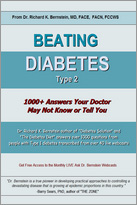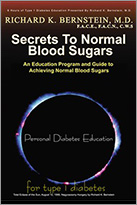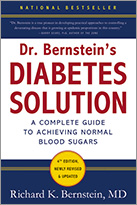Hypoglycemia is not the only cause of loss of consciousness. Stroke, heart attack, a sudden drop in blood pressure, and even a bump on the head can render you unconscious. In fact, very high blood sugar (above 400 mg/dl) over several days, especially in a dehydrated individual, can also cause loss of consciousness. We will assume, however, that if you are carefully observing the treatment guidelines of this book, you will not allow such prolonged blood sugar elevation to occur.
If you’re found unconscious by someone who knows how to rapidly check your blood sugar, a measurement may be made. Treatment should not be delayed, however, while people are scampering about trying to find your testing supplies.
The treatment under these conditions is injection of glucagon, a
hormone that rapidly raises blood sugar by causing the liver and muscles to convert stored glycogen to glucose. It is imperative, therefore, that those who live with you know how to give an injection. If you use insulin, you can give them some practice by teaching them how to give you insulin injections. Glucagon is sold in pharmacies in many countries as the Glucagon Emergency Kit. This consists of a small plastic box containing a syringe filled with an inert waterlike solution and a little vial of white powder (glucagon). The kit also contains an illustrated instruction sheet that your family should read before an emergency develops. The user injects the water into the vial, withdraws the needle, shakes the vial to dissolve the powder in the water, and draws the solution back into the syringe. The tip of the long needle must be
submerged in the liquid. For adults, the entire contents of the syringe should be injected, either intramuscularly or subcutaneously; lesser amounts should be used for small children. Any of the sites shown in Figure 16-1 on page 251 can be used, as can the deltoid muscle (page 309) or even the calf muscle. Your potential benefactors should be warned that if they choose the buttocks, injection should go into the upper outer quadrant, so as not to injure the sciatic nerve. An injection
may be given through clothing provided it is not too thick (for example, through a shirtsleeve or trouser leg, but not through a coat or jacket).
Under no circumstances should anything be administered by mouth while you are unconscious.
Since you will not be able to swallow, oral glucose could asphyxiate you. If your glucagon cannot be found, your companions should dial 911 (in the United States) for the
emergency medical service, or you should be taken to the emergency room of a hospital.
When an individual has lost consciousness from hypoglycemia, he
may experience convulsions. Signs of this include salivation, tooth grinding, and tongue-biting. Although the last can cause permanent damage in the mouth, no attempt to intervene should be made. Your heroic savior will not be able to help you if you bite off her fingers. If possible, you should be turned to lie on your side with your head positioned so that your mouth is downward. This is to help drain excess saliva from your mouth so you won’t breathe it in and choke.
You should begin to show signs of recovery within 5 minutes of a
glucagon injection. You should fully regain consciousness and be able to talk sensibly within 20 minutes at most. If steady improvement is not apparent during the first 10 minutes, the only recourse is the emergency squad or hospital. The emergency squad should be asked to inject 40 cc of a 50 percent dextrose (glucose) solution into a vein. Individuals weighing under 100 pounds (45 kilograms) should receive proportionately smaller amounts (e.g., a 70-pound child would receive 20 cc of the dextrose solution).
Glucagon can cause retching or vomiting in some people. Your
head should therefore be turned to the side so that if you do vomit, you won’t inhale the vomitus. Keep a 4-ounce (120 ml) bottle of metoclopramide syrup on hand, attached with a rubber band to the Glucagon Emergency Kit. One gulp of metoclopramide, taken after you are sitting up and speaking, should almost immediately stop the feeling of nausea. Do not consume more than one gulp, as large doses can cause unpleasant side effects (see page 368). In the United States, metoclopramide is available only upon prescription by
a physician.
One dose of glucagon can raise your blood sugar by as much as 250 mg/dl, depending upon how much glycogen was stored in your liver at the time of the injection and subsequently converted to glucose. After you’ve fully recovered your senses, you should check your blood sugar. If at least 5 hours have elapsed since your last dose of a rapid-acting insulin, take enough intramuscular (or subcutaneous) lispro (or aspart or glulisine) insulin to bring your blood sugar back down to your
target. This is important, because if your blood sugar is kept normal for about 24 hours, your liver will rebuild its supply of glycogen. This glycogen reserve is of great value for protection from possible subsequent hypoglycemic events.
By the way, if we tried to give glucagon to someone twice in the
same day, the second shot might not raise blood sugar. This is possible because liver glycogen reserves may have been totally depleted in response to the first injection. Thus, monitoring and correction of blood sugar every 5 hours for 1 full day is mandatory after the use of glucagon.
Additional blood sugar measurements should be taken every
2. hours to make sure that you’re not again hypoglycemic, but do not correct for high blood sugars every 2. hours; wait the full 5 hours since the last shot of rapid-acting insulin (see page 305).
Although reading about possible loss of consciousness may be
frightening, remember that this is an extremely rare event, and usually results when a type 1 diabetic makes a major mistake, such as those included in the list on pages 319–320. I know of no case where a type 2 diabetic experienced severe hypoglycemia when using any medication that we recommend.




